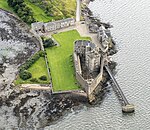Charlestown railway station (ER)
1833 establishments in Scotland1863 disestablishments in ScotlandDisused railway stations in FifeFife railway station stubsPages with no open date in Infobox station ... and 3 more
Railway stations in Great Britain closed in 1863Railway stations in Great Britain opened in 1833Use British English from April 2020
Charlestown (ER) railway station served the town of Charlestown, Fife, Scotland from 1833 to 1863 on the Elgin Railway.
Excerpt from the Wikipedia article Charlestown railway station (ER) (License: CC BY-SA 3.0, Authors).Charlestown railway station (ER)
Shell Road,
Geographical coordinates (GPS) Address Nearby Places Show on map
Geographical coordinates (GPS)
| Latitude | Longitude |
|---|---|
| N 56.0367 ° | E -3.5054 ° |
Address
Shell Road
KY11 3ET
Scotland, United Kingdom
Open on Google Maps








